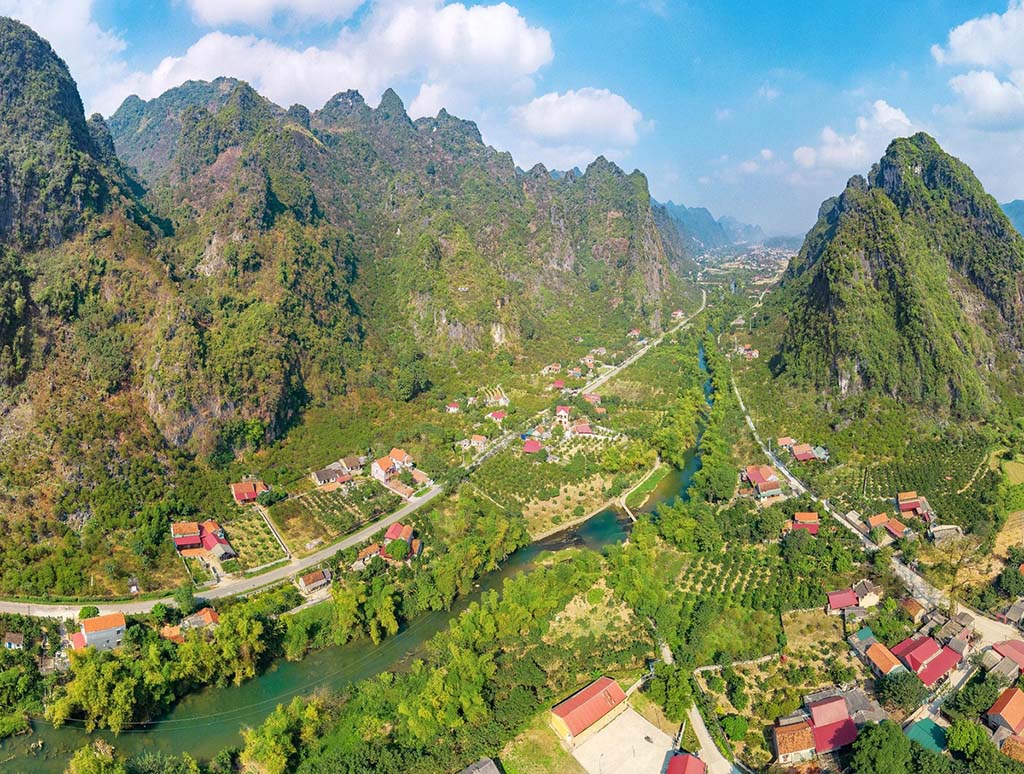
13+ Notable and Beautiful Tourist Spots in Lang Son, Vietnam
With numerous lyrical landscapes and renowned historical artifacts, Lang Son is the first region of the fatherland. Along with its extensive natural beauty, wonders, and ancient historical monuments, this country also boasts a very distinctive culture and cuisine. Let's now examine the well-known and alluring tourist attractions in Lang Son in this post.
When someone mentions Lang Son, many people will instantly see Mu Son, a location that has recently seen a lot of ice and snow and drawn a lot of tourists. Although many visitors are unaware of it, this region also contains a wide variety of other landscapes and historical locations. Let's look at some of the popular tourist attractions in Lang Son below to help you plan your itinerary.
1. Mau Son
By being compared to the "sleeping princess in the forest," Mau Son - Lang Son tourism draws tourists from all over the world. Cold temperatures, clean air, and little to no smog may be found in the tourist region of Mau Son. Being surrounded by the vastness of nature and taking in the majesty of the northeastern mountains and woods are two things that draw tourists to this location. December through February of next year are the finest months to visit The Mountain. The snow is blanketed in white and erases the roadways as soon as the cold air returns with vigor.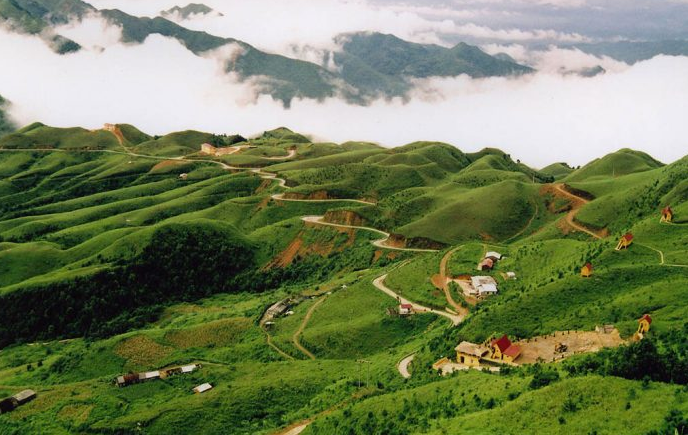 Visitors are intrigued by this location's extraordinarily diversified and rich ecosystem in addition to its stunning and unaltered natural beauty. In addition, Mau Son Mountain is a fascinating tourist site for people who are interested in learning about cultural values, national identity, and cultural values. Mau Son Lang Son is the perfect location for tourists who want to take in the magnificent natural scenery of mountains and woods, learn about the traditional values of ethnic minorities, and savor the delectable cuisine of the Tay ethnic people.
Visitors are intrigued by this location's extraordinarily diversified and rich ecosystem in addition to its stunning and unaltered natural beauty. In addition, Mau Son Mountain is a fascinating tourist site for people who are interested in learning about cultural values, national identity, and cultural values. Mau Son Lang Son is the perfect location for tourists who want to take in the magnificent natural scenery of mountains and woods, learn about the traditional values of ethnic minorities, and savor the delectable cuisine of the Tay ethnic people.
- Address: Mau Son Commune, Cao Loc District, Lang Son Province.
- How to move: It simply takes 4-5 hours to drive the 200 km (124 mi) in the National Highway 1A route from Hanoi to Mau Son.
2. Bac Son Valley
Bac Son Valley is located in the province of Lang Son, 160 km north of Hanoi, and is 500–1200 m above sea level. The "Bac Son Society" is the name of an ancient civilisation that formerly flourished on this territory, and it is the location of the heroic revolutionary cradle and the location of the ruins of a well-known archeological culture. The towering limestone mountains and wide rice fields that encircle the Bac Son Valley create a picturesque natural setting that draws tourists.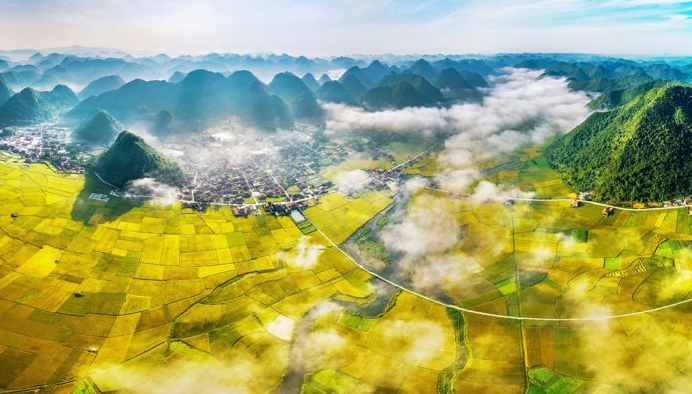 People frequently produce two rice crops in Bac Son Valley due to its flat, spacious terrain and pleasant weather all year long. The Bac Son valley dons a golden silk garment towards the end of July or the beginning of October during the ripe rice season. Additionally, from Na Lay Peak, you can observe the entire Bac Son valley's landscape, including the yellow hue of the ripe rice carpets and, in the distance, the roof of the Quynh Son Community Tourism Culture Village.
People frequently produce two rice crops in Bac Son Valley due to its flat, spacious terrain and pleasant weather all year long. The Bac Son valley dons a golden silk garment towards the end of July or the beginning of October during the ripe rice season. Additionally, from Na Lay Peak, you can observe the entire Bac Son valley's landscape, including the yellow hue of the ripe rice carpets and, in the distance, the roof of the Quynh Son Community Tourism Culture Village.
- How to get there: From the center of Hanoi, visitors should head to Nhat Tan Bridge, then to Vo Nguyen Giap Street, then to National Highway 18B to Hanoi Highway, then to Thai Nguyen, and finally to Bac Son.
3. Tam Thanh Pagoda
Tam Thanh Pagoda is part of a complex of three caves called Nhat Thanh, Nhi Thanh, and Tam Thanh. It is not only famous for its beautiful scenery, but it is also a spiritual destination for Buddhists and visitors whenever the New Year arrives in spring. Because the temple is located in the relic complex of Tam Thanh Cave, visitors must go through 30 stone steps carved by the ancients from the mountainside where the temple is located. Tam Thanh Pagoda is built in a cave and lacks the same architectural style as other temples.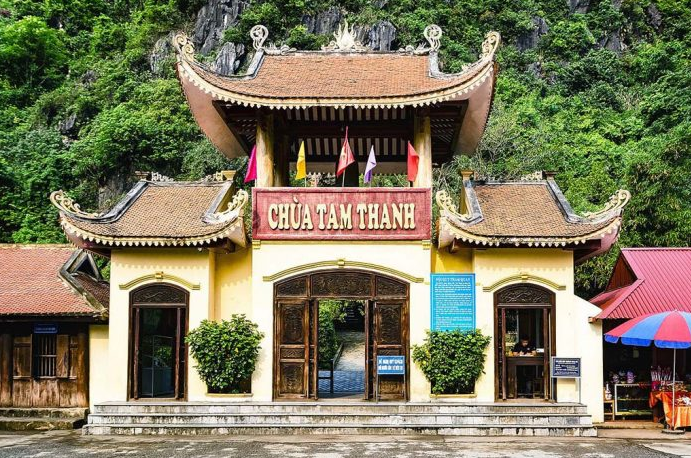 A distinctive aspect of the structure is a 17th-century Adià edema that was carved into a cliff in the form of a bodhi leaf, particularly in the temple. Visitors to Tham Thanh Pagoda not only adore the unusual and enigmatic beauty of the natural surroundings, but also immerse themselves in the celebratory atmosphere with various traditional practices of Lang Son.
A distinctive aspect of the structure is a 17th-century Adià edema that was carved into a cliff in the form of a bodhi leaf, particularly in the temple. Visitors to Tham Thanh Pagoda not only adore the unusual and enigmatic beauty of the natural surroundings, but also immerse themselves in the celebratory atmosphere with various traditional practices of Lang Son.
- Address: Tam Thanh Ward, Lang Son City, Lang Son Province.
- Ticket price: VND 20,000 per person.
4. Bac Xa
Bac Xa is a high mountainous area in Lang Son province's Dinh Lap district. Visitors can get to the center of Bac Xa commune by following National Highway 31 from Dinh Lap town. Visitors will be drawn here by the beautiful scenery, rustic villages on both sides of the road with winding roads winding in the green mist of pine forests and mop forests.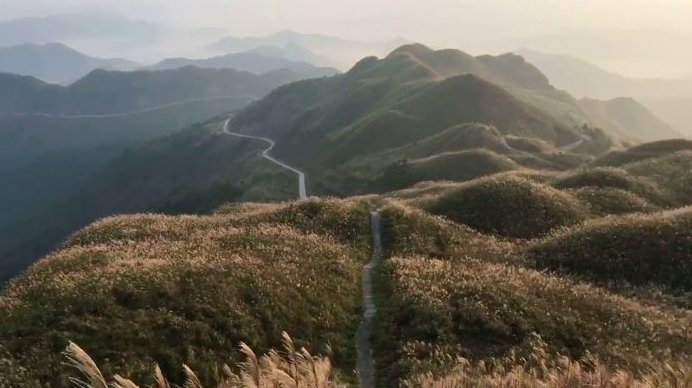 Bac Xa is also known as a commune with many border landmarks (40 milestones), one of which is located on high hilltops, is quite solidly built, and has a coal level leading to the top, such as 1297 and 1300. These two landmarks are well-known for their height and majestic landscapes. Visitors must conquer the hill and cross the steep uphill steps, which span nearly 1km in length, in order to check in at these two milestones. The two sides of the road leading up to the milestone are blooming mops that create a poetic and romantic scene, making visitors' footsteps continue despite their desire to stop.
Bac Xa is also known as a commune with many border landmarks (40 milestones), one of which is located on high hilltops, is quite solidly built, and has a coal level leading to the top, such as 1297 and 1300. These two landmarks are well-known for their height and majestic landscapes. Visitors must conquer the hill and cross the steep uphill steps, which span nearly 1km in length, in order to check in at these two milestones. The two sides of the road leading up to the milestone are blooming mops that create a poetic and romantic scene, making visitors' footsteps continue despite their desire to stop.
5. Dang Mo Falls
20 kilometers from Bac Son, in the Binh Gia district, are the Dang Mo Falls. It is a waterfall surrounded by mountains and trees that is both wild and hospitable. The Dang Mo Falls are a confluence of subterranean water pressures in the mountain range of Bac Son rock. The limestone mountains' arc's rough terrain makes the area around the waterfall pristine and small in the midst of the mountains and forests. To suggest that this location is like a "gift" from nature to this country is not an exaggeration.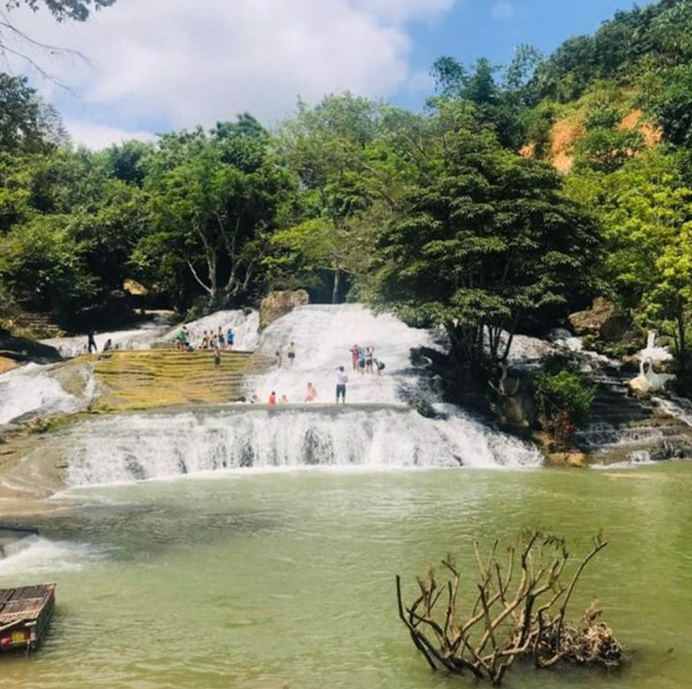 Visitors can admire large and small stones of various shapes and sizes that are covered in green moss as they walk along the waterfall. The ancient trees that stretch in the middle of the waterfall on both sides of the shore add to the mystery and charm of this place. It's a few hundred meters through three rock floors from the top of the waterfall to the bottom of the waterfall. From a distance, the waterfall appears to be a strip of silk crossed through the gentle mountains and forests. Dang M Waterfall poured all year round, the water bumped into the rock to release white foam, making the waterfall look like "radiating sparkling light" in the mountains and forests of thousands of people.
Visitors can admire large and small stones of various shapes and sizes that are covered in green moss as they walk along the waterfall. The ancient trees that stretch in the middle of the waterfall on both sides of the shore add to the mystery and charm of this place. It's a few hundred meters through three rock floors from the top of the waterfall to the bottom of the waterfall. From a distance, the waterfall appears to be a strip of silk crossed through the gentle mountains and forests. Dang M Waterfall poured all year round, the water bumped into the rock to release white foam, making the waterfall look like "radiating sparkling light" in the mountains and forests of thousands of people.
- How to Get There: From Lang Son City, take National Highway 1B towards Bac Son. Go about 10 kilometers further from Bac Son town, turn onto National Highway 270, and go another 11 kilometers to see the waterfall.
6. To Thi Mountain
To Thi Mountain, also known as Vong Phu Mountain, is located in Lang Son's Tam Thanh commune. Legend has it that To Thi once waited with her children for her husband to respond by fighting. The mother and daughter were terrified as they waited in vain for her husband. To Thi Mountain was thus named. The legend of To Thi has captured the hearts of the Vietnamese people as a representation of women's loyalty and steely fortitude, with the image of the mother waiting for her husband on top of the mountain while carrying her child. This monument has been destroyed over time as a result of natural and human forces. The original has been rebuilt in Lang Son province to preserve a relic that has captured the hearts of the Vietnamese people. The To Thi statue in the complex of monuments, Tam Thanh landscape, Lang Son coastal city is one of the themes for many songs, poems, and feelings composed by Vietnamese people throughout the generations, including the immortal Hon Vong Phu case as a symbol of Vietnamese women's iron-son loyalty.
This monument has been destroyed over time as a result of natural and human forces. The original has been rebuilt in Lang Son province to preserve a relic that has captured the hearts of the Vietnamese people. The To Thi statue in the complex of monuments, Tam Thanh landscape, Lang Son coastal city is one of the themes for many songs, poems, and feelings composed by Vietnamese people throughout the generations, including the immortal Hon Vong Phu case as a symbol of Vietnamese women's iron-son loyalty.
- How to get there: Visitors can take the Hanoi-Bac Ninh-Bac Giang-Lang Son route or follow National Highway 5 to Road 1A.
7. Long Dau Stream
Long Dau Stream is one of Lang Son Province's most well-known attractions and ecotourism destinations. Long Dau Stream is approximately 10 kilometers long and flows through the communes of Mau Son and Yen Ngai in the Loc Binh district. Long Dau Stream embodies the scenery of the Mau Son mountainous region. The narrow and steep stream bed creates numerous rapids, and spring water flows all year round, resulting in numerous smooth rocks. Except during the rainy season, when the water flows like floods, the water flows smoothly, clear, fresh air, and cool during the other seasons.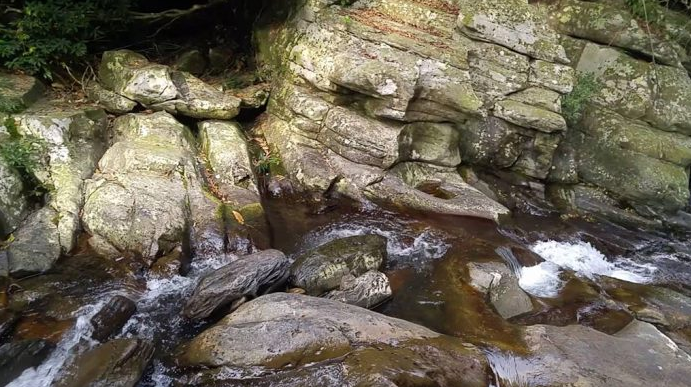 The stream flows north-south through the steep slopes and old forests of The Village of Lap Pia to the lower region from the majestic Mau Son mountain range at an elevation of over 1000m. There are very large waterfalls upstream that can reach more than 3m in height, 7-15m in width, and 2-3m in depth. Long Dau Stream, if properly adorned, can vie with Khoang Xanh and Ao Vua as a popular tourist destination. Let's get your cloth shoes and a stick ready to climb the mountain "traveling streams"! Many surprises await visitors' steps.
The stream flows north-south through the steep slopes and old forests of The Village of Lap Pia to the lower region from the majestic Mau Son mountain range at an elevation of over 1000m. There are very large waterfalls upstream that can reach more than 3m in height, 7-15m in width, and 2-3m in depth. Long Dau Stream, if properly adorned, can vie with Khoang Xanh and Ao Vua as a popular tourist destination. Let's get your cloth shoes and a stick ready to climb the mountain "traveling streams"! Many surprises await visitors' steps.
8. Mau Dong Dang Temple
The Mau Dong Dang Temple, located in Dong Dang town, Cao Loc district, Lang Son province, is a place of worship for the thousand-year-old Upper Mother and Buddha poetry. The temple has unique architectural, religious, and historical significance. Every year on January 10th, there is a bad spring festival, which often includes games such as ethnic martial arts, lion dance, and sports competitions. Mother Dong Dang Temple has five worshiping halls: Outside is Tam Toa Thanh Mau, followed by Son Trang's worship area; the space between the outermost main hall worships Lord Lieu, the two sides are Chau Bo and Chau Luc; and the left space worships the Tu Kham Sai. Visitors to the Mau Dong Dang Lang Son Temple can also offer incense and pray. Visitors will be heard by their superiors and blessed for their sincerity. At the same time, each person will have hope for a better life.
Mother Dong Dang Temple has five worshiping halls: Outside is Tam Toa Thanh Mau, followed by Son Trang's worship area; the space between the outermost main hall worships Lord Lieu, the two sides are Chau Bo and Chau Luc; and the left space worships the Tu Kham Sai. Visitors to the Mau Dong Dang Lang Son Temple can also offer incense and pray. Visitors will be heard by their superiors and blessed for their sincerity. At the same time, each person will have hope for a better life.
- Address: Dong Dang Town, Cao Loc District, Lang Son Province.
9. Chi Lang Pass
Chi Lang Pass is a heroic historical site that attracts many international tourists, national players, historians, and others. Chi Lang Pass, located in Chi Lang commune, is a typical historical gate of Lang Son province. Previously, this area was thought to be a Thang Long barrier to prevent northern farsightedness. 3km wide connecting the districts of Chi Lang and Huu Tung in Lang Son province.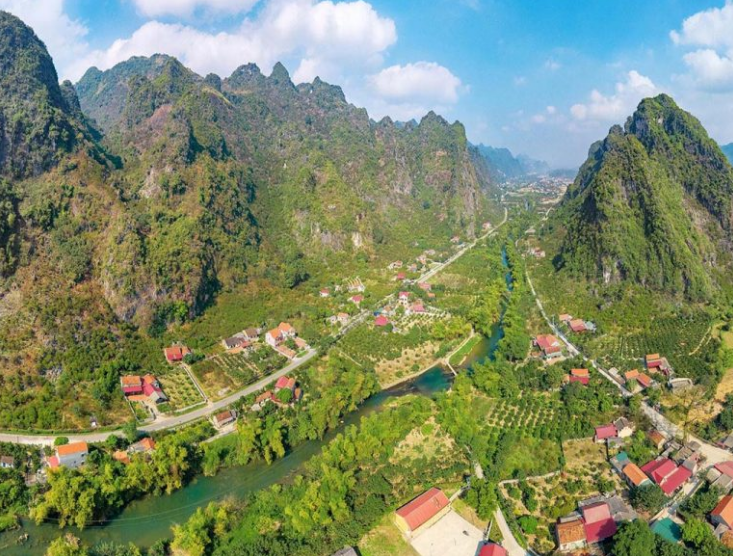 Chi Lang Pass is not only a beautiful place in the middle of the sky, but it also contains the intense vitality of the ancient Dong A. Previously, Chi Lang Pass created a weak battle and became a wall protecting the ancient Thang Long city due to its unique terrain of high mountains and covered trees. Invasions. This border region's history is filled with heroic figures such as Tran Quoc Tuan, Ly Thuong Kiet, and Hoang Dai Huu... Chi Lang witnessed the victories of fighting the French and driving out the Japanese of our militia in the nineteenth and twentieth centuries.
Chi Lang Pass is not only a beautiful place in the middle of the sky, but it also contains the intense vitality of the ancient Dong A. Previously, Chi Lang Pass created a weak battle and became a wall protecting the ancient Thang Long city due to its unique terrain of high mountains and covered trees. Invasions. This border region's history is filled with heroic figures such as Tran Quoc Tuan, Ly Thuong Kiet, and Hoang Dai Huu... Chi Lang witnessed the victories of fighting the French and driving out the Japanese of our militia in the nineteenth and twentieth centuries.
10. Mat Quy Mountain (Devil's Face Mountain)
Quan Thanh village is home to the mountain with the devil's face (Chi Lang commune, Chi Lang district, Lang Son province). That is why this location was previously known as the Quy Mon Quan (Demon Gate, also known as the devil's face door). This mountain is unique in that it is located in the middle of a plant-filled green space, revealing a shape that resembles the face of a giant monster. Visitors will notice that the mountains are covered in eyes and noses from a distance. Locals also couldn't explain why, after thousands of years, the devil's face still hasn't grown as densely as other nearby areas.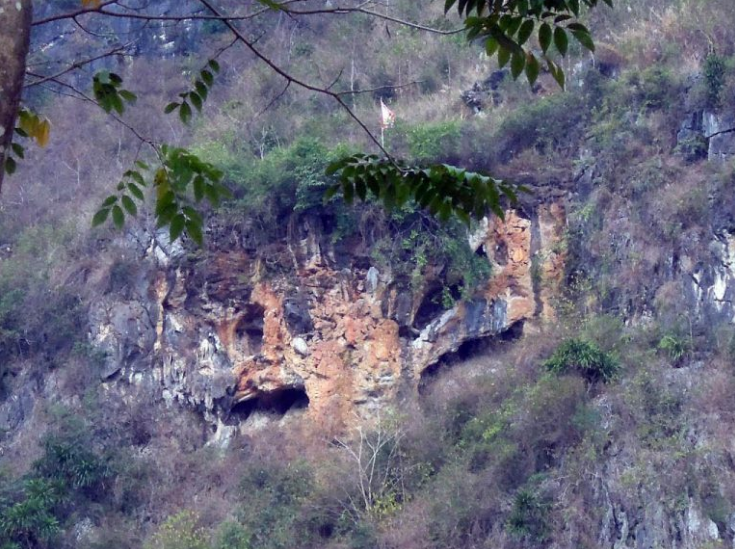 During the winter wind season, visitors to Lang Son are familiar with the howl of the wind as it blows through the cave chain of the devil-shaped mountain, as if the call from the sound, stoic and terrifying. No one dares to climb the mountain because it is regarded as the devil's face. Climbing the mountain of the devil's face, they believe, is disrespectful to the "creator" and will result in punishment from the devil. Interestingly, despite the fact that it is said to be the devil's face, the people here do not regard it as a symbol of evil, but rather believe that the "devil's face" will protect the peace of the river for the villagers.
During the winter wind season, visitors to Lang Son are familiar with the howl of the wind as it blows through the cave chain of the devil-shaped mountain, as if the call from the sound, stoic and terrifying. No one dares to climb the mountain because it is regarded as the devil's face. Climbing the mountain of the devil's face, they believe, is disrespectful to the "creator" and will result in punishment from the devil. Interestingly, despite the fact that it is said to be the devil's face, the people here do not regard it as a symbol of evil, but rather believe that the "devil's face" will protect the peace of the river for the villagers.
11. Hang Gio (the Wind Cave)
Thong Gio Cave and Mai Sao Phong Cave are other names for Wind Cave. Wind Cave is in Lung Khom (Sao Thuong B village), Mai Sao commune, Chi Lang district. The Hang Gio relic region is vast, with numerous rocky rocks and natural caves in the Bo Nhan mountain range stretching from Sao Thuong hamlet to the center of Mai Sao commune. The Wind Cave is the most visible of these. The cave is huge in scale, with lengths reaching hundreds of meters, widths reaching 50-70 meters, and heights reaching 30-40 meters in certain spots. Wind Cave has two floors and a basement, as well as a few side niches, making it less perilous and easier to explore. The cave's arch is tall and wide, and the cave's floor is relatively flat and open, resembling a cathedral dome. Visitors to the Wind Cave (Ventilation Cave) must first visit the Wind Cave (Ventilation Cave) to step up to 392 steps in the shape of a long limb to reach the Wind Cave, then visit other surrounding caves such as Princess Cave (i.e. Stage Cave), Prince Cave (i.e. Bright Cave), Thien Dinh Cave, Bat Cave, Daffodil Cave, and others (i.e. Water Cave). The Wind Cave door features two doors, one in front and one in back. The entrance door (east) is 15m wide, and the cave ceiling is 10m high. The back door (west) is 36m wide, and the cave ceiling is 20m high.
Visitors to the Wind Cave (Ventilation Cave) must first visit the Wind Cave (Ventilation Cave) to step up to 392 steps in the shape of a long limb to reach the Wind Cave, then visit other surrounding caves such as Princess Cave (i.e. Stage Cave), Prince Cave (i.e. Bright Cave), Thien Dinh Cave, Bat Cave, Daffodil Cave, and others (i.e. Water Cave). The Wind Cave door features two doors, one in front and one in back. The entrance door (east) is 15m wide, and the cave ceiling is 10m high. The back door (west) is 36m wide, and the cave ceiling is 20m high.
The journey to The Wind Cave is quite convenient; if traveling from Hanoi to Lang Son, we can drive a car along the new National Highway 1A, which is 120 kilometers from the center of Hanoi.
12. Thanh Lang Son Pagoda
Because of its ancient and sacred nature, Thanh Lang Son Pagoda is well-known among both domestic and international tourists. Every year, many tourists choose Thanh Lang Son Pagoda as a spiritual tourist destination because of its unique architecture. This is also a temple with many records recognized by Buddhist organizations, promising visitors interesting experiences and discoveries when they visit.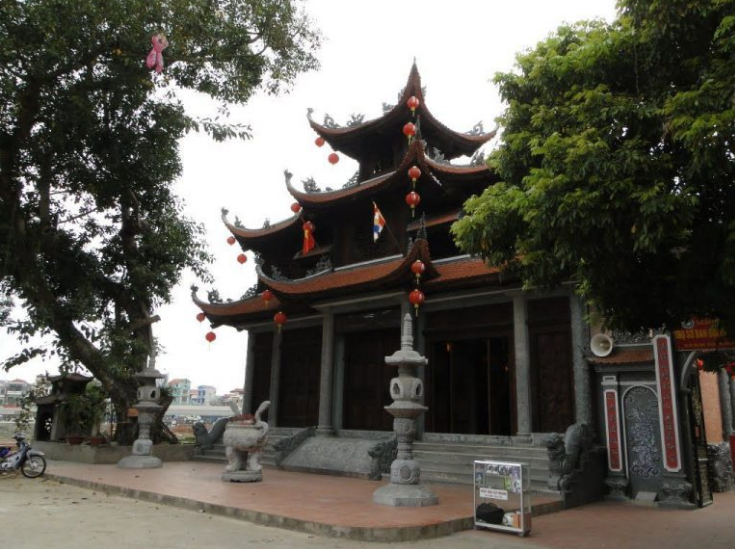 Huong Lam Tu Temple, located in Mai Pha commune, was built in the 15th century. The temple was moved to its current location in 1796. Later, the temple was renamed Dien Khanh Tu. This temple was renamed Tuan Khanh Tu in 1846, during King Thieu Tri's reign. It wasn't until later that the old name was reinstated as Dien Khanh Tu. Because this temple is located right in the heart of the old city, the locals refer to it as Lang Son Thanh Pagoda.
Huong Lam Tu Temple, located in Mai Pha commune, was built in the 15th century. The temple was moved to its current location in 1796. Later, the temple was renamed Dien Khanh Tu. This temple was renamed Tuan Khanh Tu in 1846, during King Thieu Tri's reign. It wasn't until later that the old name was reinstated as Dien Khanh Tu. Because this temple is located right in the heart of the old city, the locals refer to it as Lang Son Thanh Pagoda.
- How to get there: From the center of Hanoi, take the Chuong Duong Bridge to Highway 5, then cross the overpass. Visitors continue on the Hanoi - Bac Giang highway after reaching National Highway 1A. Continue on National Highway 1A and National Highway 37 to Hung Vuong Road in Yen Trach. Visitors to Hung Vuong will arrive at the foot of Ky Co Bridge, which also serves as the location of Thanh Lang Son Pagoda.
13. Relics of Tien Pagoda
Song Tien Pagoda is another name for the ruins of Tien Lang Son Pagoda. The temple is on Hoang Hoa Tham Street in Lang Son's Chi Lang Ward, in the heart of Dai Tuong Mountain. The location is approximately 500 meters from the Ky Cung Bridge. The temple is a place rich in cultural values and beliefs. Folk tales and ancient statues exude national pride.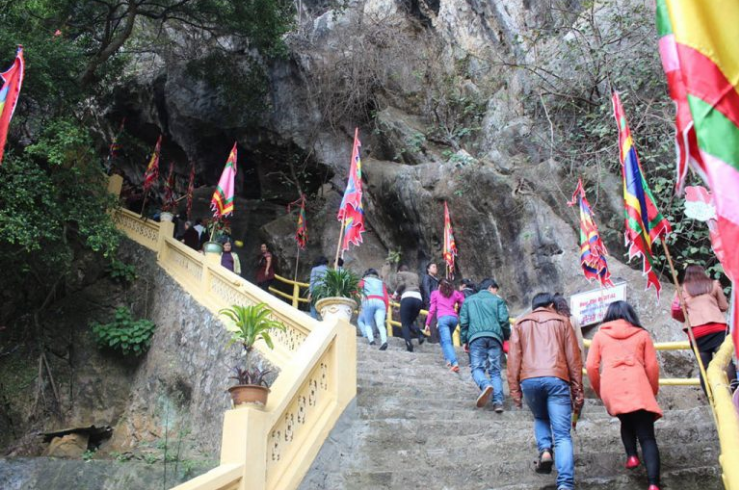 Aside from the records of the preceding history. According to locals, the birth of Tien Pagoda relics is also linked to an extremely intriguing positive classic. The architecture of the temple deep within the rock cave is very unique. Dong Tien, unlike the other Lang Son pagodas, is not located near the foot of Dai Tuong mountain. Visitors must ascend more than 65 meandering stone steps to enter the cave and view the temple scene. The stone step has railings and is not slippery, making it very easy to walk. Tourists can easily make their way up to the temple.
Aside from the records of the preceding history. According to locals, the birth of Tien Pagoda relics is also linked to an extremely intriguing positive classic. The architecture of the temple deep within the rock cave is very unique. Dong Tien, unlike the other Lang Son pagodas, is not located near the foot of Dai Tuong mountain. Visitors must ascend more than 65 meandering stone steps to enter the cave and view the temple scene. The stone step has railings and is not slippery, making it very easy to walk. Tourists can easily make their way up to the temple.
The list above includes some of the most popular Lang Son tourist sites. If you get the opportunity to return to Lang Son, do not pass up the appealing sites listed above; each will provide tourists with a fascinating experience.